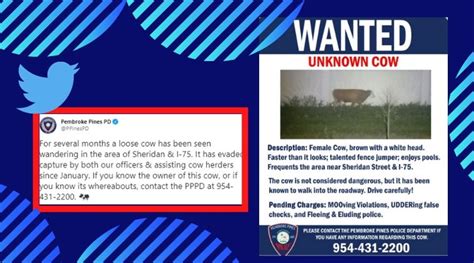
A 77-year-old Florida man, Ronald Staley, is facing felony charges after allegedly shooting his neighbor’s cow five times with a .22-caliber rifle because it wandered onto his property in Okeechobee County. The incident, which occurred on June 5th, resulted in serious injuries to the cow, prompting an investigation by the Okeechobee County Sheriff’s Office. Staley claims he shot the animal because it was destroying his property, while the cow’s owner disputes this, stating the cow was gentle and posed no threat.
Florida Man Charged After Shooting Neighbor’s Cow Multiple Times
Okeechobee County, FL – Ronald Staley, 77, of Okeechobee County, Florida, has been arrested and charged with aggravated animal cruelty and using a firearm during the commission of a felony after he allegedly shot his neighbor’s cow five times. The incident occurred on June 5th when the cow wandered onto Staley’s property.
According to the Okeechobee County Sheriff’s Office, deputies responded to a call regarding an animal shooting. Upon arrival, they discovered a severely injured cow belonging to Staley’s neighbor. The cow had sustained multiple gunshot wounds, and the owner was attempting to provide aid.
The investigation revealed that Staley admitted to shooting the cow with a .22-caliber rifle. He claimed that the cow was on his property and was causing damage, leading him to take action. However, the cow’s owner refuted Staley’s claims, asserting that the cow was docile and posed no threat to Staley or his property.
“The cow was described by its owner as gentle,” stated the Sheriff’s Office report.
The severity of the cow’s injuries prompted immediate veterinary care. The veterinarian who examined the cow determined that it had been shot five times and required extensive treatment. The Okeechobee County Sheriff’s Office stated the injuries constituted aggravated animal cruelty, leading to Staley’s arrest.
Staley was taken into custody and booked into the Okeechobee County Jail. He faces charges of aggravated animal cruelty, a felony in Florida, and using a firearm during the commission of a felony. These charges carry significant penalties, including potential imprisonment and fines.
The incident has sparked outrage in the local community and beyond, with animal rights advocates condemning Staley’s actions. The case highlights the ongoing issues of animal cruelty and property disputes in rural areas.
Legal and Ethical Considerations
The case raises several legal and ethical considerations. Florida law, like that of many states, protects animals from cruelty and abuse. Aggravated animal cruelty, as defined under Florida Statute 828.12, involves intentionally inflicting unnecessary pain or suffering on an animal. This can include actions that cause serious physical injury or death.
The statute specifies that a person who commits an act involving aggravated animal cruelty commits a felony of the third degree, punishable by imprisonment for up to five years and a $10,000 fine. Furthermore, the use of a firearm during the commission of a felony carries additional penalties under Florida law, potentially increasing the severity of the sentence.
In this case, the prosecution will likely argue that Staley’s actions constitute aggravated animal cruelty because he intentionally shot the cow multiple times, causing it severe pain and suffering. The defense may argue that Staley was acting in self-defense or to protect his property, though the cow owner’s assertion that the animal was docile will likely undermine this argument.
From an ethical standpoint, the incident raises questions about the responsibility of property owners to handle trespassing animals humanely. While property owners have a right to protect their land from damage, the use of lethal force against an animal is generally considered excessive unless there is an imminent threat to human safety.
Community Reaction and Animal Welfare Concerns
The news of the cow shooting has generated significant reaction within the Okeechobee County community and among animal welfare organizations. Many residents have expressed shock and dismay at the alleged actions of Staley, calling for justice for the injured cow.
Animal welfare groups have condemned the shooting as a senseless act of violence. They emphasize the importance of responsible pet and livestock ownership, as well as the need for stricter enforcement of animal cruelty laws. Some organizations have called for increased education and awareness about animal rights and the proper handling of conflicts involving animals.
The incident also underscores the challenges faced by law enforcement in rural areas, where interactions between humans and animals are common. Sheriff’s offices must balance the rights of property owners with the need to protect animals from harm. This requires careful investigation and the application of relevant laws and regulations.
The Cow’s Condition and Ongoing Care
Following the shooting, the injured cow was immediately taken to a veterinarian for treatment. The veterinarian’s examination revealed multiple gunshot wounds, requiring surgery and ongoing care. The cow’s condition was initially critical, but with intensive treatment, it has shown signs of improvement.
The cost of the cow’s medical care has been substantial, and the owner has faced significant financial challenges. Local animal welfare organizations and community members have rallied to support the cow’s recovery, providing donations and assistance.
The cow’s long-term prognosis remains uncertain, and it may suffer lasting effects from its injuries. However, the outpouring of support from the community has provided hope for its full recovery.
Property Rights vs. Animal Welfare
The case of the Florida man shooting the cow brings to light the tension between property rights and animal welfare. Property owners have the right to protect their land from damage and trespassers, but these rights are not absolute. The use of force, especially lethal force, against an animal must be justified by a reasonable fear of harm or significant property damage.
Many states have laws that outline the circumstances under which a property owner can legally take action against an animal on their property. These laws often require the property owner to make reasonable efforts to contact the animal’s owner before resorting to lethal force.
In this case, it is unclear whether Staley made any attempt to contact the cow’s owner before shooting the animal. His claim that the cow was damaging his property is disputed by the owner, who describes the cow as gentle. This raises questions about whether Staley’s actions were justified under the law.
The legal and ethical debate over property rights and animal welfare is ongoing. Balancing the rights of property owners with the need to protect animals from cruelty requires careful consideration of the specific circumstances of each case.
Historical Context of Animal Cruelty Laws
Animal cruelty laws have evolved significantly over time, reflecting changing societal attitudes toward animals. In the past, animals were often viewed primarily as property, with little legal protection against abuse. However, in recent decades, there has been growing recognition of the intrinsic value of animals and the importance of protecting them from unnecessary suffering.
The first animal cruelty laws in the United States were enacted in the mid-19th century, driven by concerns about the mistreatment of animals used for labor and transportation. These early laws focused primarily on preventing acts of cruelty that were considered particularly egregious, such as beating or torturing animals.
Over time, animal cruelty laws have become more comprehensive, covering a wider range of actions and providing greater protection for animals. Today, all 50 states have laws that prohibit animal cruelty, and many states have specific provisions for aggravated animal cruelty, which carries more severe penalties.
The evolution of animal cruelty laws reflects a growing understanding of the cognitive and emotional capacities of animals. Scientific research has shown that many animals are capable of experiencing pain, fear, and other emotions similar to those experienced by humans. This has led to a greater emphasis on the humane treatment of animals and the prevention of unnecessary suffering.
Impact on Rural Communities
Incidents like the cow shooting can have a significant impact on rural communities. These communities often rely on agriculture and livestock farming, and the well-being of animals is closely tied to the economic and social fabric of the community.
Animal cruelty can erode trust between neighbors and create tension within the community. It can also raise concerns about the safety and welfare of other animals in the area. In some cases, animal cruelty can be a sign of broader social problems, such as domestic violence or substance abuse.
Law enforcement agencies in rural areas play a critical role in addressing animal cruelty and promoting responsible pet and livestock ownership. This requires collaboration with animal welfare organizations, veterinarians, and community members.
Role of Law Enforcement in Animal Cruelty Cases
Law enforcement officers are often the first responders to animal cruelty cases. They are responsible for investigating allegations of abuse, gathering evidence, and making arrests when appropriate.
Investigating animal cruelty cases can be challenging, as it often requires specialized knowledge and skills. Law enforcement officers must be able to recognize signs of animal abuse, collect and preserve evidence, and work with veterinarians and other experts to build a strong case.
Many law enforcement agencies have specialized units or officers who are trained to investigate animal cruelty cases. These units can provide valuable expertise and support to officers in the field.
Preventative Measures and Education
Preventing animal cruelty requires a multi-faceted approach that includes education, legislation, and enforcement. Education is essential for raising awareness about animal rights and the proper care and treatment of animals.
Schools, community organizations, and animal welfare groups can play a role in educating people about animal welfare. This can include teaching children about the importance of treating animals with kindness and respect, as well as providing information about responsible pet ownership.
Legislation is also important for setting standards for animal care and holding abusers accountable. Strong animal cruelty laws can deter potential offenders and provide a basis for prosecuting those who abuse animals.
Enforcement is necessary to ensure that animal cruelty laws are effectively implemented. Law enforcement agencies must have the resources and training to investigate animal cruelty cases and bring offenders to justice.
The Importance of Reporting Animal Cruelty
Reporting suspected animal cruelty is crucial for protecting animals from harm. Anyone who witnesses or suspects animal abuse should report it to their local law enforcement agency or animal control agency.
When reporting animal cruelty, it is important to provide as much information as possible, including the date, time, and location of the incident, as well as a description of the animal and the alleged abuser. Photos and videos can also be helpful in documenting the abuse.
Reporting animal cruelty can be difficult, especially if the abuser is a friend or family member. However, it is important to remember that animals are vulnerable and rely on humans to protect them from harm.
Future of Animal Welfare Laws
The future of animal welfare laws is likely to involve continued efforts to strengthen protections for animals and hold abusers accountable. This could include expanding the definition of animal cruelty to cover a wider range of actions, increasing penalties for animal abuse, and providing greater resources for law enforcement and animal welfare organizations.
There is also a growing movement to recognize animals as sentient beings with rights of their own. This could lead to significant changes in the way animals are treated in society, including greater protections for their welfare.
The case of the Florida man shooting the cow serves as a reminder of the importance of protecting animals from cruelty and promoting responsible pet and livestock ownership. By working together, communities can create a more humane world for all animals.
The Aftermath: Legal Proceedings and Community Healing
As Ronald Staley awaits his day in court, the Okeechobee County community grapples with the aftermath of the shooting. The legal proceedings will determine Staley’s fate, but the broader issue of animal welfare and responsible gun ownership remains a topic of discussion. Local organizations are planning community events to promote animal safety and educate residents on conflict resolution with wildlife and livestock. The incident has also prompted a review of existing county ordinances related to livestock management and responsible gun use within residential areas. The goal is to prevent similar incidents and foster a stronger sense of community responsibility towards animals.
FAQ: Frequently Asked Questions About the Florida Cow Shooting Incident
-
What exactly happened in the Okeechobee County cow shooting incident?
Ronald Staley, a 77-year-old Florida man, allegedly shot his neighbor’s cow five times with a .22-caliber rifle after it wandered onto his property. He claims the cow was damaging his property, while the owner disputes this. Staley has been arrested and charged with aggravated animal cruelty and using a firearm during the commission of a felony.
-
What charges is Ronald Staley facing, and what are the potential penalties?
Staley is facing charges of aggravated animal cruelty and using a firearm during the commission of a felony. In Florida, aggravated animal cruelty is a third-degree felony, punishable by imprisonment for up to five years and a $10,000 fine. The use of a firearm during the commission of a felony carries additional penalties, potentially increasing the severity of the sentence.
-
What is the condition of the cow that was shot, and what is being done to help it?
The cow sustained multiple gunshot wounds and required extensive veterinary care, including surgery. While its condition was initially critical, it has shown signs of improvement with intensive treatment. Local animal welfare organizations and community members have provided donations and assistance to support the cow’s recovery.
-
What legal rights do property owners have when livestock wanders onto their property?
Property owners have the right to protect their property from damage, but the use of force against an animal must be justified by a reasonable fear of harm or significant property damage. Many states have laws outlining the circumstances under which a property owner can legally take action against an animal on their property, often requiring reasonable efforts to contact the animal’s owner before resorting to lethal force. In Florida, using lethal force must be justified.
-
How can I report suspected animal cruelty in Florida, and what information should I provide?
If you suspect animal cruelty in Florida, report it to your local law enforcement agency or animal control agency. Provide as much information as possible, including the date, time, and location of the incident, as well as a description of the animal and the alleged abuser. Photos and videos can also be helpful in documenting the abuse. Contact the Okeechobee County Sheriff’s Office to report any incident.









